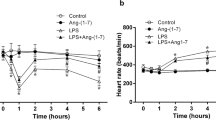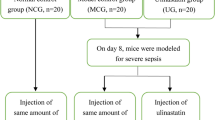Abstract
Protamine causes cardiac depression, which may be mediated by tumor necrosis factor alpha (TNF-α). Ulinastatin, a human urinary protease inhibitor, inhibits TNF-α. Here, we aimed to investigate whether ulinastatin prevented protamine-induced myocardial depression by inhibiting TNF-α. Rat hearts were perfused using a Langendorff system, and three protocols were followed. Protocol 1: The hearts were divided into saline, ulinastatin-low, and ulinastatin-high groups. Protamine was administered to each group, and myocardial contractility was the primary outcome. Protocol 2: The hearts were allotted to saline or ulinastatin group. Protamine was administered to each group. TNF-α expression in the coronary effluent and myocardial tissue was measured. Protocol 3: The hearts were allotted to saline and ulinastatin groups. Recombinant rat-TNF-α was administered to each group. Protamine alone reduced the maximum left ventricular pressure derivative (LV dP/dt max) by 45 ± 4%. In contrast, the reduction in LV dP/dt max was 4 ± 3% in the ulinastatin-high group. Compared with that in the saline group, the increase in TNF-α in the coronary effluent was attenuated in the ulinastatin group. Recombinant TNF-α alone reduced LV dP/dt max (− 21 ± 14%). In contrast, when TNF-α was added in the presence of ulinastatin, the decrease in LV dP/dt max was prevented significantly (− 3 ± 8%). We showed, for the first time, that ulinastatin protected against protamine-induced myocardial damage, both by inhibiting TNF-α synthesis and by directly preventing the cardiodepressant action of TNF-α.





Similar content being viewed by others
Data availability
The original source data sets are available in Supplementary Tables.
References
Aosasa S, Ono S, Mochizuki H, Tsujimoto H, Ueno C, Matsumoto A (2001) Mechanism of the inhibitory effect of protease inhibitor on tumor necrosis factor alpha production of monocytes. Shock 15:101–105
Bao P, Gao W, Li S, Zhang L, Qu S, Wu C, Qi H (2009) Effect of pretreatment with high-dose ulinastatin in preventing radiation-induced pulmonary injury in rats. Eur J Pharmacol 603:114–119. https://doi.org/10.1016/j.ejphar.2008.12.007
Boer C, Meesters MI, Veerhoek D, Vonk ABA (2018) Anticoagulant and side-effects of protamine in cardiac surgery: a narrative review. Br J Anaesth 120:914–927. https://doi.org/10.1016/j.bja.2018.01.023
Cain BS, Harken AH, Meldrum DR (1999a) Therapeutic strategies to reduce TNF-alpha mediated cardiac contractile depression following ischemia and reperfusion. J Mol Cell Cardiol 31:931–947. https://doi.org/10.1006/jmcc.1999.0924
Cain BS, Meldrum DR, Dinarello CA, Meng X, Joo KS, Banerjee A, Harken AH (1999b) Tumor necrosis factor-alpha and interleukin-1beta synergistically depress human myocardial function. Crit Care Med 27:1309–1318
David JS, Vivien B, Lecarpentier Y, Coriat P, Riou B (2001) Interaction of protamine with alpha- and beta-adrenoceptor stimulations in rat myocardium. Anesthesiology 95:1226–1233
Freitas CF, Faro R, Dragosavac D, Clozel M, De Nucci G, Antunes E (2004) Role of endothelin-1 and thromboxane A2 in the pulmonary hypertension induced by heparin-protamine interaction in anesthetized dogs. J Cardiovasc Pharmacol 43:106–112
Giroir BP, Horton JW, White DJ, McIntyre KL, Lin CQ (1994) Inhibition of tumor necrosis factor prevents myocardial dysfunction during burn shock. Am J Phys 267:H118–H124
Huang Y, Xie K, Zhang J, Dang Y, Qiong Z (2008) Prospective clinical and experimental studies on the cardioprotective effect of ulinastatin following severe burns. Burns 34:674–680. https://doi.org/10.1016/j.burns.2007.08.024
Katircioglu SF, Ulus T, Yamak B, Saritas Z, Yildiz U (1999) Experimental inhibition of protamine cardiotoxicity by prostacyclin. Angiology 50:929–935
Kleinbongard P, Schulz R, Heusch G (2011) TNFalpha in myocardial ischemia/reperfusion, remodeling and heart failure. Heart Fail Rev 16:49–69. https://doi.org/10.1007/s10741-010-9180-8
Meldrum DR, Dinarello CA, Cleveland JC Jr, Cain BS, Shames BD, Meng X, Harken AH (1998) Hydrogen peroxide induces tumor necrosis factor alpha-mediated cardiac injury by a P38 mitogen-activated protein kinase-dependent mechanism. Surgery 124:291–296; discussion 297. https://doi.org/10.1067/msy.1998.90570
Oguchi T, Doursout MF, Kashimoto S, Liang YY, Hartley CJ, Chelly JE (2001) Role of heparin and nitric oxide in the cardiac and regional hemodynamic properties of protamine in conscious chronically instrumented dogs. Anesthesiology 94:1016–1025
Oral H, Dorn GW 2nd, Mann DL (1997) Sphingosine mediates the immediate negative inotropic effects of tumor necrosis factor-alpha in the adult mammalian cardiac myocyte. J Biol Chem 272:4836–4842
Pevni D et al (2001) Protamine-induced cardiotoxicity is prevented by anti-TNF-alpha antibodies and heparin. Anesthesiology 95:1389–1395
Ramzan R et al (2019) Protamine sulfate induces mitochondrial hyperpolarization and a subsequent increase in reactive oxygen species production. J Pharmacol Exp Ther 370:308–317. https://doi.org/10.1124/jpet.119.257725
Sabbadini RA, Betto R, Teresi A, Fachechi-Cassano G, Salviati G (1992) The effects of sphingosine on sarcoplasmic reticulum membrane calcium release. J Biol Chem 267:15475–15484
Tsujimura S, Saito K, Nakayamada S, Tanaka Y (2008) Bolus infusion of human urinary trypsin inhibitor improves intractable interstitial pneumonia in patients with connective tissue diseases. Rheumatology (Oxford) 47:907–913. https://doi.org/10.1093/rheumatology/ken067
Wakefield TW, Wrobleski SK, Nichol BJ, Kadell AM, Stanley JC (1992) Heparin-mediated reductions of the toxic effects of protamine sulfate on rabbit myocardium. J Vasc Surg 16:47–53
Xie X, Li T, Yuan H (2019) Protective effects of ulinastatin on oxidative stress and inflammation of rat-derived cardiomyocytes H9c2. Am J Transl Res 11:7094–7103
Xu L, Ren B, Li M, Jiang F, Zhanng Z, Hu J (2008) Ulinastatin suppresses systemic inflammatory response following lung ischemia-reperfusion injury in rats. Transplant Proc 40:1310–1311. https://doi.org/10.1016/j.transproceed.2008.01.082
Xu CE, Zou CW, Zhang MY, Guo L (2013) Effects of high-dose ulinastatin on inflammatory response and pulmonary function in patients with type-A aortic dissection after cardiopulmonary bypass under deep hypothermic circulatory arrest. J Cardiothorac Vasc Anesth 27:479–484. https://doi.org/10.1053/j.jvca.2012.11.001
Yang ZH, Lu YJ, Gu KP, Xiang ZY, Huang HM (2019) Effect of ulinastatin on myocardial ischemia-reperfusion injury through JNK and P38 MAPK signaling pathways. Eur Rev Med Pharmacol Sci 23:8658–8664. https://doi.org/10.26355/eurrev_201910_19183
Zhou LW, Wang YL, Yan XT, He XH (2008) Urinary trypsin inhibitor treatment ameliorates acute lung and liver injury resulting from sepsis in a rat model. Saudi Med J 29:368–373
Acknowledgments
We thank Masanobu Koshimizu, Research Assistant, University of Yamanashi, for his valuable technical assistance.
Funding
This work was supported by a Grant-in-Aid (C) (grant number 22591724) for Scientific Research (KAKENHI) from Japan Society for the Promotion of Science (JSPS).
Author information
Authors and Affiliations
Contributions
HF and TO contributed to the study conception and design. HF, TO, HS, and TS conducted experiments. Data collection and analysis were performed by TO, YN, KO, AK, TM, and TM. The first draft of the manuscript was written by HF, and all authors commented on previous versions of the manuscript. All authors read and approved the final manuscript.
Corresponding author
Ethics declarations
Conflict of interest
The authors declare that they have no conflict of interest.
Ethics approval
This study was approved by the Ethics Committee on Animal Research of the University of Yamanashi (protocol number A24-27).
Disclaimer
The authors do not have any financial or commercial interest in the subject matter, materials, or equipment discussed. The authors declare that all data were generated in-house and that no paper mill was used.
Additional information
Publisher’s note
Springer Nature remains neutral with regard to jurisdictional claims in published maps and institutional affiliations.
Rights and permissions
About this article
Cite this article
Fukushima, H., Oguchi, T., Sato, H. et al. Ulinastatin attenuates protamine-induced cardiotoxicity in rats by inhibiting tumor necrosis factor alpha. Naunyn-Schmiedeberg's Arch Pharmacol 394, 373–381 (2021). https://doi.org/10.1007/s00210-020-01983-2
Received:
Accepted:
Published:
Issue Date:
DOI: https://doi.org/10.1007/s00210-020-01983-2




